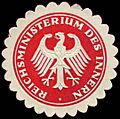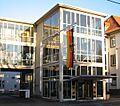Federal Ministry of the Interior (Germany) facts for kids
| Bundesministerium des Innern (BMI) | |
 |
|
 |
|
| Agency overview | |
|---|---|
| Formed | 24 December 1879 as the Reichsamt des Inneren 23 May 1949 in the current form |
| Jurisdiction | Government of Germany |
| Headquarters | Alt-Moabit 140 10557 Berlin 52°31′17″N 13°21′44″E / 52.52139°N 13.36222°E |
| Employees | 60,000 (subordinate agencies) 1,500 (ministry) |
| Annual budget | €18.458 billion (2021) |
| Minister responsible |
|
| Agency executives |
|
| Child agencies |
|
| Website | https://www.bmi.bund.de/EN/home/home_node.html |
The Federal Ministry of the Interior and Community (German: Bundesministerium des Innern und für Heimat, abbreviated BMI) is a very important government office in Germany. It is like the "Home Office" in the UK or parts of the "Department of Homeland Security" in the USA. Its main job is to keep Germany safe and secure from the inside.
The BMI has its main office in Berlin and another office in Bonn. The current minister in charge is Nancy Faeser. This ministry manages several important groups that help with law enforcement and security. These include the Federal Police and the Federal Criminal Police Office. It also oversees the agency that protects Germany's constitution, called the Federal Office for the Protection of the Constitution.
Contents
History of the Ministry
The story of this ministry began a long time ago.
Early Beginnings
The first version of this ministry was called the Reichsamt des Innern (Imperial Office of the Interior). It was created on December 24, 1879, during the time of the German Empire. It was set up by the Reichskanzler (Chancellor) Otto von Bismarck. This office was directly controlled by the Chancellor. Its main office was in Berlin.
Changes Over Time
Later, on February 11, 1919, this Imperial Office became the Reichsministerium des Innern (Ministry of the Interior). It continued to be Germany's Ministry of the Interior during the Weimar Republic and Nazi Germany. In 1934, it joined with the Prussian Ministry of the Interior.
After World War II ended in 1945, the old Imperial Ministry stopped working. In 1949, the current Federal Ministry was created. It served as the Interior Ministry for West Germany until German reunification in 1990.
In 2018, the ministry's name changed to "Interior, Building and Homeland." This happened when it joined with the building department. The word Heimat means "homeland" or "home" in German.
What the Ministry Does
The Federal Ministry of the Interior and Community has many important jobs to keep Germany running smoothly and safely.
Ensuring Internal Security
One of its main tasks is to make sure Germany is safe inside its borders. This includes protecting the country from dangers like terrorism. It also works to protect the country's constitution, which is the main set of rules for the government.
Disaster and Emergency Help
The ministry is also in charge of civil protection. This means it helps people during disasters like floods or storms. It also prepares for emergencies and helps people recover afterward.
Managing Administration and Immigration
The ministry handles many administrative tasks for the government. It is also responsible for matters related to immigration, refugees, and helping new people settle into Germany.
Supporting Sports
Surprisingly, the ministry also deals with sports! It helps with sports policies and supports sports activities across the country.
Fighting Terrorism Together
Since 2004, the ministry has hosted the Joint Anti-Terrorism Center. This is a place where all German police and intelligence agencies share information. They work together to fight terrorism more effectively.
How the Ministry is Organized
The Federal Ministry of the Interior and Community is a large organization with many different parts.
Leaders and Departments
The minister is helped by several state secretaries. These people help manage the different departments of the ministry. Each department has a specific area of focus:
- Police Department (P): This department works on law enforcement and fighting crime. It helps improve police work and crime prevention. It also manages the Federal Criminal Police Office.
- Internal Security Department (IS): This part protects Germany from political extremism. It oversees the Federal Office for Constitution Protection. It also works on civil defense and emergency management.
- Federal Police Department (B): This department supervises and manages the operations of the German Federal Police.
- Migration Department (M): This department handles immigration, helping people integrate into society, and refugees. It also works on European rules for these topics.
- Central Office Department (Z): This is the main administrative office for the ministry.
- Civil Service Department (D): This part is responsible for matters related to government employees.
- Modernization Department (O): This department works on making government administration more modern and efficient.
- Legal Department (V): This department handles legal questions related to the constitution, state laws, and European law.
- Policy and International Affairs Department (G): This department focuses on overall policy, European matters, and international developments.
- Society Affairs Department (H): This department deals with various topics related to society.
- Sport Department (SP): This department is responsible for sports-related matters.
- Digital Society, Digital State, and Cyber Security Departments: These departments focus on digital topics, including making the government more digital and protecting against cyber threats.
- Construction and Housing Departments: These departments handle issues related to construction, housing, and public buildings.
Special Agencies
The ministry also oversees many special agencies that help with its work. Here are some of them:
- Federal Office for Migration and Refugees (BAMF)
- Federal Office for the Protection of the Constitution (BfV)
- Federal Police (BPOL)
- Federal Institute for Population Research (BiB)
- Federal Criminal Police Office (BKA)
- Federal Agency for Cartography and Geodesy (BKG)
- Federal Agency for Civic Education (BpB)
- Federal Office for Information Security (BSI)
- Federal Office of Administration (BVA)
- Federal Office of Civil Protection and Disaster Assistance (BBK)
- Federal Statistical Office (StBA)
- Federal Agency for Technical Relief (THW)
Images for kids
See also





